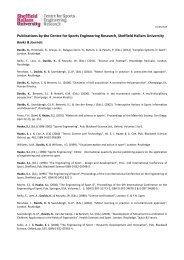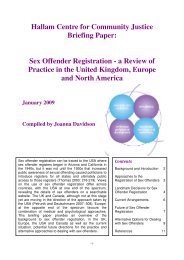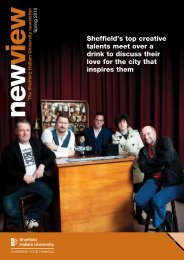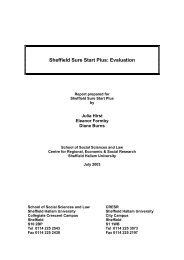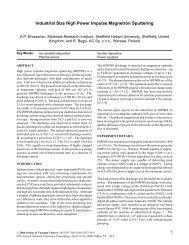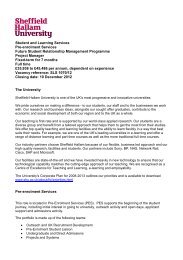A life for design - Sheffield Hallam University
A life for design - Sheffield Hallam University
A life for design - Sheffield Hallam University
Create successful ePaper yourself
Turn your PDF publications into a flip-book with our unique Google optimized e-Paper software.
6<br />
Review<br />
Feature<br />
Thomas Heatherwick<br />
7<br />
By Tess Humphrys<br />
Review<br />
“I<br />
do think everyone has<br />
their own mix of skills and<br />
aptitudes and <strong>for</strong>ms of<br />
creativity and intelligence, mixed in<br />
different combinations,” says Thomas<br />
Heatherwick, in a typically modest<br />
response from a <strong>design</strong>er who is<br />
regularly called a creative “genius” by<br />
those in the know.<br />
“I suppose it’s just trying to find<br />
a place to be which meets your<br />
particular mix. I feel talk of creativity<br />
is often overrated, it’s what you’re<br />
going to do with it that’s the thing,”<br />
he says.<br />
The sell-out event was the<br />
culmination of a successful<br />
partnership between the RIBA<br />
and the <strong>University</strong>, which saw<br />
the successful Forgotten Spaces<br />
2011: <strong>Sheffield</strong> architectural ideas<br />
competition take place in the city.<br />
Thomas, who received an honorary<br />
doctorate from <strong>Sheffield</strong> <strong>Hallam</strong> in<br />
2003 <strong>for</strong> services to architecture,<br />
describes himself as a ‘maker’ above<br />
anything else. He has become known<br />
<strong>for</strong> his large-scale public projects,<br />
such as the Rolling Bride in London<br />
and the magical waterfall-like<br />
Bleigiessen sculpture, made from 15<br />
tonnes of glass.<br />
Last year Thomas <strong>design</strong>ed and<br />
directed the ‘seed head’ British<br />
pavilion at the Shanghai World<br />
Expo. The Seed Cathedral was<br />
constructed from 60,000 20 metre<br />
long transparent optical strands, each<br />
of which had a seed embedded within<br />
its tip. It received 50,000 visitors a day<br />
throughout the five month-long event<br />
catapulting Thomas, and his work,<br />
to international acclaim within the<br />
<strong>design</strong> and architecture world.<br />
Feature Thomas Heatherwick<br />
A <strong>life</strong> <strong>for</strong> <strong>design</strong><br />
In November, world-renowned <strong>design</strong>er Thomas<br />
Heatherwick gave an insight into his illustrious career<br />
at a sell-out event, co-hosted by the Royal Institute of<br />
British Architects (RIBA) and the <strong>University</strong>. We went<br />
to meet him in his London studio.<br />
But it’s not praise and success that<br />
drive him, rather his innate curiosity<br />
about how things work, and how to<br />
make them better.<br />
“I’ve always been someone who’s<br />
interested in the ideas behind things,<br />
how things work and why they<br />
work the way they work,” he says<br />
surrounded by the projects and partprojects<br />
that litter his light, modern<br />
London studio.<br />
“But I’m only interested if something<br />
can become reality.”<br />
His studio, which he established in<br />
1994, is multi-disciplinary and exists<br />
to ‘make extraordinary projects<br />
happen’. It reflects Thomas’ own<br />
approach of practically-applied<br />
creativity, and he identifies with<br />
the set up of the <strong>University</strong>’s own<br />
multi-disciplinary faculty of Arts,<br />
Computing, Engineering and<br />
Sciences.<br />
Indeed Thomas concedes he works<br />
with people with a whole range<br />
of skills to achieve his ambitious<br />
projects.<br />
“It’s <strong>for</strong> a very good reason that I’m<br />
surrounded by lots of people, because<br />
it’s like we create a group brain,”<br />
he says.<br />
“It’s through dialogue that we<br />
are squeezing things into being.<br />
Something always grows from people<br />
being involved rather than it just<br />
being me.”<br />
This need to work with others to<br />
achieve the best possible results is<br />
what, in Thomas’ opinion, university<br />
students can find most difficult,<br />
and he feels that education can<br />
sometimes limit people’s ability, and<br />
desire, to work collaboratively.<br />
“The hard thing <strong>for</strong> students is that<br />
they’re all by themselves,” he says. “I<br />
found that it was possible to do things<br />
by yourself, but it came alive when I<br />
was working with other people.”<br />
And he admits: “The scale of the<br />
projects that I’m interested in you<br />
can’t make happen by yourself<br />
anyway.”<br />
The coming year will see Thomas<br />
achieve more mainstream fame, with<br />
two high-profile projects about to<br />
be realised.<br />
In November, the first of his<br />
re<strong>design</strong>ed London buses rolled off<br />
the production line and the fleet is<br />
due <strong>for</strong> wide-spread launch in 2012.<br />
It’s the first time in 50 years<br />
that Transport <strong>for</strong> London have<br />
commissioned <strong>design</strong>ers to look<br />
at how the famous Routemaster<br />
double deckers can be improved, and<br />
Thomas and his team have relished<br />
the challenge.<br />
“Some of the worst environments<br />
we are in are bus moments,” he says.<br />
“There are not many places where<br />
you’re willing to sit with a fluorescent<br />
tube above your head. Keep<br />
fluorescent lights in a piggery!<br />
“We felt there’s a sort of dignity that<br />
has evaporated from buses, which<br />
isn’t quite the same with other <strong>for</strong>ms<br />
of transport.”<br />
“I’m only interested<br />
if something<br />
can become reality.”<br />
Thomas Heatherwick



